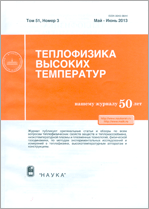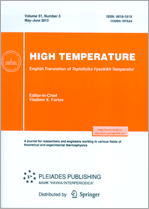|
|
Teplofizika vysokikh temperatur, 2004, Volume 42, Issue 2, Pages 181–191
(Mi tvt1505)
|
|
|
 |
This article is cited in 14 scientific papers (total in 14 papers)
Plasma Investigations
Simulation of a dc discharge in a transverse supersonic gas flow
S. A. Dvinin, A. P. Ershov, I. B. Timofeev, V. A. Chernikov, V. M. Shibkov
M. V. Lomonosov Moscow State University
Abstract:
This study is devoted to the investigation of a dc discharge in a transverse gas flow. It is shown that the discharge may exist in several forms depending on the gas flow velocity. The standard stationary discharge similar to a discharge in still gas is realized if the displacement rate of the plasma boundary exceeds the gas flow velocity. The displacement rate of the plasma boundary in a diffusion model is defined by the relation $V_f=2\sqrt{D_a\nu_i}$, where $D_a$ is the ambipolar diffusion coefficient, and $\nu_i$ is the frontal ionization frequency. Otherwise, the discharge assumes the form of two plasma wakes formed by the cathode and anode, respectively. The surface of the plasma wakes is oriented at an angle $\alpha$ to the flow velocity $C_S(\sin\alpha=V_f/C_S)$. If $\alpha$ is smaller than the ratio of the discharge sustaining voltage in the stationary regime $U_{st}$ st to the breakdown voltage $U_{bk}$, the discharge transforms into the pulse–periodic form, when the formation of a structure of the cathode and anode plasma wakes is interrupted by a new gas breakdown. A numerical simulation of the discharge properties is performed. The numerical simulation results are compared to the experimental ones.
Received: 12.02.2003
Citation:
S. A. Dvinin, A. P. Ershov, I. B. Timofeev, V. A. Chernikov, V. M. Shibkov, “Simulation of a dc discharge in a transverse supersonic gas flow”, TVT, 42:2 (2004), 181–191; High Temperature, 42:2 (2004), 171–182
Linking options:
https://www.mathnet.ru/eng/tvt1505 https://www.mathnet.ru/eng/tvt/v42/i2/p181
|


| Statistics & downloads: |
| Abstract page: | 205 | | Full-text PDF : | 213 |
|





 Contact us:
Contact us: Terms of Use
Terms of Use
 Registration to the website
Registration to the website Logotypes
Logotypes







 Citation in format
Citation in format 
